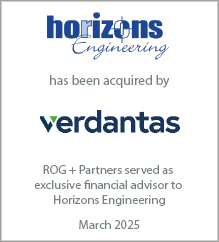Michael S. O'Brien is a principal in the Washington, DC office of Rusk O'Brien Gido + Partners. He specializes in corporate financial advisory services including business valuation, fairness and solvency opinions, mergers and acquisitions, internal ownership transition consulting, ESOPs, and strategic planning. Michael has consulted hundreds of architecture, engineering, environmental and construction companies across the U.S. and abroad.
What Is Your Ownership Strategy?
October 10, 2019
Does your firm have an ownership strategy that clearly defines how you will be able to exit your firm? Are you relying on selling your firm to a third-party or the next generation of leaders? According to the Census Bureau and assuming age 67 for retirement, more than 9,000 people a day are hitting retirement age, and this is expected to increase to over 12,000 by 2028. During this same period, the gap between the number of buyers and sellers will likely narrow and, in some years, will be negative. This gap will not widen to significant levels until 2035. Over the next 15 years, transitioning ownership will be one of the biggest challenges for A/E firm leaders.
The chasm between buyers and sellers seem to be increasing, which is making ownership planning more challenging. Buyers – likely Millennials – have a different appreciation for risk/rewards trade-off, and many have higher student debt obligations than previous generations. Compounding this chasm are the sellers – likely to be Baby Boomers – who are reluctant to give up control and are not satisfied with their valuation because they’ve invested so much into their company, but have not been taking anything out. They are banking on the “End of the Rainbow” value.
Many firms elect an internal ownership transition plan because sustaining their business and ensuring the welfare of their employees is most important to them. While an internal transition plan is often the path that most firms choose, it doesn’t take the external ownership plan off the table. Many firms develop their internal transition plans with the desire to sell to a third party in the future. However, will the market be in their favor? If not, they still have the option of transferring internally.
The share repurchase obligation is one of the biggest risks of a closely held company. Since the redemption of shares is not a tax-deductible expense, for every $1.00 of stock value that is redeemed, a company needs to generate about $1.41 of cash flow. Managing this tax risk leads firms to seek alternative ways to improve liquidity for their shares by discounting their value, tying in equity-based deferred compensation plans, or sponsoring partial or 100% ESOP ownership plans.
Selling shareholders are finding it more difficult to get a fair value for their ownership interest in a closely held A/E firm. As a result, I am seeing more firms relying on discounted stock valuation and delivering high returns in the form of dividend payments to offset low stock appreciation. Also, more firms are sponsoring ESOP ownership plans to take advantage of their tax benefits – especially 100% S-Corp ESOP ownership plans – as these firms become tax-exempt entities. Over the past two years, I have rendered more fairness opinions for firms converting their ownership to 100% S-Corp ESOPs than the previous 15 years. Will this trend continue?
Learn more about the latest ownership and value-enhancing trends that are occurring in the architecture, engineering, environmental consulting industry at the ROG Growth & Ownership Strategies Conference in Naples, Florida, November 6 – 8. For more information feel free to contact Michael at mobrien@rog-partners.com.
The chasm between buyers and sellers seem to be increasing, which is making ownership planning more challenging. Buyers – likely Millennials – have a different appreciation for risk/rewards trade-off, and many have higher student debt obligations than previous generations. Compounding this chasm are the sellers – likely to be Baby Boomers – who are reluctant to give up control and are not satisfied with their valuation because they’ve invested so much into their company, but have not been taking anything out. They are banking on the “End of the Rainbow” value.
Many firms elect an internal ownership transition plan because sustaining their business and ensuring the welfare of their employees is most important to them. While an internal transition plan is often the path that most firms choose, it doesn’t take the external ownership plan off the table. Many firms develop their internal transition plans with the desire to sell to a third party in the future. However, will the market be in their favor? If not, they still have the option of transferring internally.
The share repurchase obligation is one of the biggest risks of a closely held company. Since the redemption of shares is not a tax-deductible expense, for every $1.00 of stock value that is redeemed, a company needs to generate about $1.41 of cash flow. Managing this tax risk leads firms to seek alternative ways to improve liquidity for their shares by discounting their value, tying in equity-based deferred compensation plans, or sponsoring partial or 100% ESOP ownership plans.
Selling shareholders are finding it more difficult to get a fair value for their ownership interest in a closely held A/E firm. As a result, I am seeing more firms relying on discounted stock valuation and delivering high returns in the form of dividend payments to offset low stock appreciation. Also, more firms are sponsoring ESOP ownership plans to take advantage of their tax benefits – especially 100% S-Corp ESOP ownership plans – as these firms become tax-exempt entities. Over the past two years, I have rendered more fairness opinions for firms converting their ownership to 100% S-Corp ESOPs than the previous 15 years. Will this trend continue?
Learn more about the latest ownership and value-enhancing trends that are occurring in the architecture, engineering, environmental consulting industry at the ROG Growth & Ownership Strategies Conference in Naples, Florida, November 6 – 8. For more information feel free to contact Michael at mobrien@rog-partners.com.








